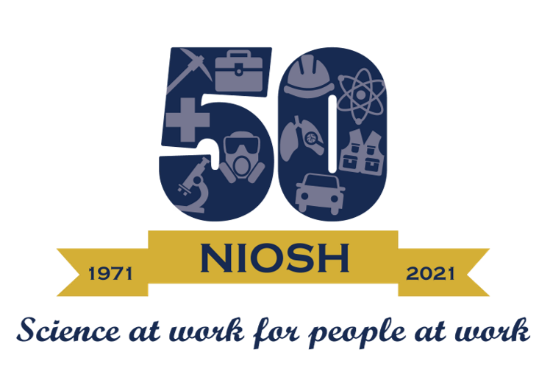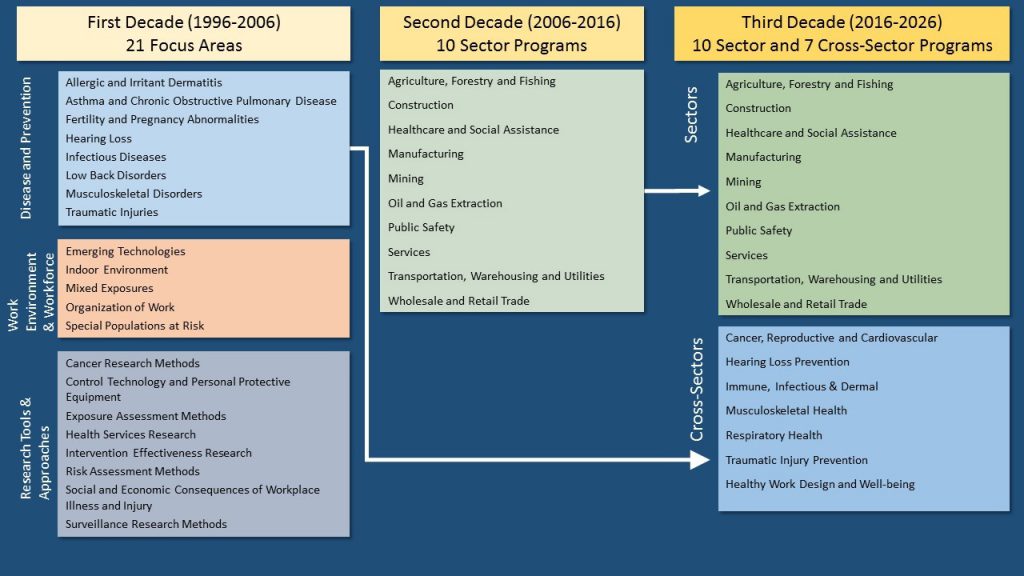Celebrating 25 Years of the National Occupational Research Agenda
Posted on byThe National Occupational Research Agenda (NORA) is a partnership program to stimulate innovative research and improved workplace practices and has become a research framework for NIOSH and the nation. Created in 1996 with input from more than 500 individuals and organizations, partnership has been key to the development and success of NORA. While NIOSH is the steward of NORA, it is just one of many partners that make NORA possible. NORA teams, and later councils, have served as unique forums to bridge gaps, encourage new research, and  promote the adoption of effective workplace interventions. Examples of achievements of the NORA Councils are highlighted below. NORA was unveiled during the NIOSH 25th anniversary. As NIOSH celebrates 50 years, let’s look back on how NORA has evolved alongside changing workplaces and celebrate the accomplishments of NORA councils.
promote the adoption of effective workplace interventions. Examples of achievements of the NORA Councils are highlighted below. NORA was unveiled during the NIOSH 25th anniversary. As NIOSH celebrates 50 years, let’s look back on how NORA has evolved alongside changing workplaces and celebrate the accomplishments of NORA councils.
First Decade (1996-2006)
In the first decade, the guiding questions were, “What will the workplace of 2006 look like? What research will be needed to ensure a safe and healthy workplace?” To respond to these challenges, the first decade of NORA was organized into 21 focus areas, grouped under the general categories of (a) Disease and Prevention, (b) Work Environment and Workforce, and (c) Research Tools and Approaches. Twenty teams led the development and dissemination of new research under each NORA topic. Team membership included individuals from universities, professional organizations, major manufacturing industries, leaders in the insurance industry, health and safety professionals from organized labor, and representatives from several government agencies. More than 500 individuals and organizations in the research and occupational safety and health community participated in setting priorities for the first decade of NORA.
Second Decade (2006-2016)
In the second decade, NORA was challenged to understand how we could better move research into practice in the workplace. NORA shifted from 21 focus areas to 8 (and later 10) industry sectors based on the North American Industry Classification System (NAICS). During this decade, each sector formed a council made up of individuals from large and small businesses, worker organizations, academia, professional societies, and other organizations. Co-led by a NIOSH researcher and an external partner, each council wrote and maintained a research agenda for the nation, which collectively made up the National Occupational Research Agenda.
Third Decade (2016-2026)
The third decade of NORA faces a slightly different challenge that asks, “What research should we be doing in 2020 and beyond?” The 10 sectors from the second decade carried forward and were joined with seven cross-sectors focused on the major health and safety issues affecting the US working population. NORA now has 17 councils that started the third decade by creating research agendas for the nation with broad occupational safety and health research objectives. They are spending the remainder of the decade working together to address the agenda through information exchange, collaboration, and enhanced dissemination and implementation of solutions that work.

NORA Council Accomplishments
NORA Councils are a powerful way to maximize resources towards improved occupational safety and health nationwide. Councils are platforms that help build close partnerships among members and broader collaborations between councils and other organizations. The resulting information sharing and leveraging efforts promotes widespread adoption of improved workplace practices based on research results.
A remarkable achievement from the second decade of NORA is the National Campaign to Prevent Falls in Construction. The signature annual event of the campaign, the National Safety Stand-Down to Prevent Falls in Construction, began in the Construction Council in 2012. Coordinated by NIOSH, the Occupational Safety and Health Administration (OSHA), and CPWR – The Center for Construction Research and Training, this activity has reached well over one million construction workers. Each year the NORA Construction Council works on new infographics and other materials to support the campaign. The 8th annual stand-down took place May 3-7, 2021. This event also inspired the NORA Construction Council Stuck-By Workgroup to host a National Stand-Down to Prevent Struck-by Incidents to address internal traffic work zone struck by incidents during National Work Zone Awareness Week in April 2020. Based on the success, this is now an annual event.
In the third decade, the NORA Manufacturing Council published a new website about hazardous energy control in September 2018. Members of the council compiled, reviewed, and adapted resources to help companies and businesses start or improve and maintain their existing lockout program. It features a resource guide with customizable materials and templates to help with implementation of effective strategies for the administrative control of unsafe release of hazardous energy.
The Respiratory Health Council created a series of four short videos called Faces of Work- Related COPD. They feature a physician (the council co-chair) explaining Chronic Obstructive Pulmonary Disease (COPD) as well as interviews with patients diagnosed with work-related COPD. The videos cover work exposures, the workers’ quality of life having the disease, and ways to minimize the risks of getting the disease. Available in English and Spanish, the videos were selected by the American Public Health Association (APHA) for screening during the APHA Film Festival in October 2020. They were also promoted by the U.S. COPD Coalition in an article on their website.
NORA Healthcare and Social Assistance (HCSA) Council hosted the “NORA Healthy Work Design in the HCSA Sector Workshop” in collaboration with the Healthy Work Design Council featuring 20 different speakers. They councils also compiled a toolkit of resources after the workshop.
The NORA Musculoskeletal Health Council posted a list of ergonomic guidance documents on the International Ergonomics Association’s Musculoskeletal Disorders Technical Committee website. The list links to more than 100 documents with interventions for reducing the risk factors for workplace musculoskeletal disorders.
Members of the Oil and Gas Extraction Council contributed to an Occupational Safety and Health Administration (OSHA), NIOSH, National STEPS Network (an association of regional Service, Transmission, Exploration & Production Safety) hazard alert Sudden Uncontrolled Pressure Release Precautions for the Oil and Gas Industry. Workers are at risk of serious injury and even death from projectile materials when uncontrolled pressure is released.
To learn more
These are just a few of the many achievements of NORA. To learn more, check out these summary reports.
- The Team Document: Ten years of leadership advancing the National Occupational Research Agenda describes the successes of the teams and reflects on lessons learned during the first decade of NORA.
- At the end of the second decade of NORA, NIOSH reviewed contributions toward improving the occupational safety and health of workers and transferring new knowledge into practice in a main report and a supplement with more specific sector and cross-sector information.
- Accomplishments from the first half of the third decade have been captured in reports for FY2016-2018, 2019, and 2020.
Contact noracoordinator@cdc.gov if you’d like to participate in a NORA Council.
Emily J.K. Novicki, MA, MPH is a health scientist in the NIOSH Office of Policy, Planning and Evaluation.
This blog is part of a series for the NIOSH 50th Anniversary. Stay up to date on how we’re celebrating NIOSH’s 50th Anniversary on our website.
Posted on by

